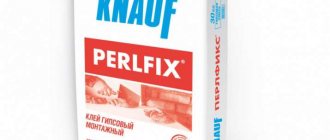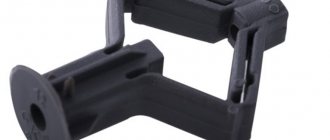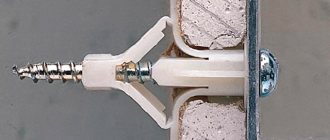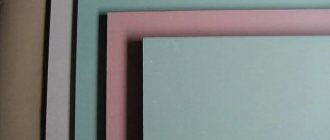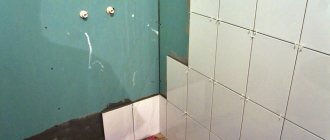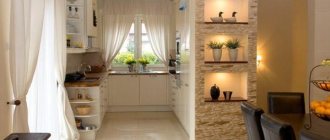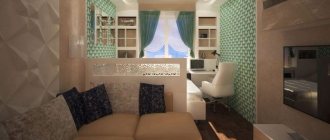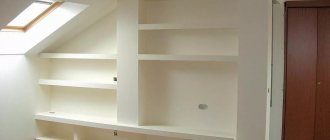Many people, when starting renovation work inside a house or apartment, are faced with uneven walls. The best option here would be to use drywall to finish them with the assembly of a frame base.
But there are situations when the walls are quite smooth. Here you can also use plasterboard for wall cladding. But in this situation, you can do without a frame and a metal profile. Here the technology of fastening plasterboard slabs using a frameless method will come into play. This article will be devoted to this issue.
Mounting options
Today, there are two main ways to install drywall on walls:
- frame assembly. To assemble it, you can use various metal profiles or wooden blocks. The method is used in situations where the walls in the room are strongly curved;
- method without assembling the frame. This method involves attaching plasterboard sheets to the wall not with a frame, but with an adhesive. This method will be simpler and faster to implement than attaching a profile and completely lathing the walls.
Due to the fact that in the vast majority of cases there is unevenness of the walls, the first method of installing plasterboard slabs using a frame and different profiles is used most often. But fastening without a frame is much less common. The frameless method is also used when it is necessary to avoid a significant reduction in space in the room. In this article we will look in detail at methods for attaching drywall to walls in a frameless manner.
Finishing OSB boards, drywall: video instructions
When making renovations in an apartment, many people think about what is better - to smooth the walls with plaster or install drywall. If you live in houses built in the 50-80s, most likely the walls there are so crooked that you can either put up with it or cover them with gypsum plasterboard slabs.
And even if you take away a little floor space, the appearance of the room will completely change; in addition, standard furniture will fit into the corners and against the wall without gaps.
Applying the mixture to the wall
Implementation requirements
The method of attaching drywall to walls without a frame can only be implemented if certain factors are present. The most important condition here that influences the choice of fastening method is the curvature of the walls. The height of the walls in the room is of great importance for the installation of drywall.
Note! The technology for installing sheets of material without the help of a frame does not involve the formation of horizontal joints. Therefore, the height of the room should be the same as that of the sheets of material.
In addition, installation of slabs here is possible if the walls are perfectly even. Only minor irregularities are allowed, which can easily be covered with plaster, thereby finally leveling the working surface of the wall.
Determining the curvature of walls
You can determine whether there is a curvature in the walls by eye. But it’s better to use a level and calculate how much one wall falls in relation to the neighboring one. This way you will be sure that the distortions are insignificant and the installation of drywall can be carried out using a frameless method. Note! If the curvature of the walls is large enough (more than 5 cm), you should use the frame method for attaching drywall. The best option to determine the curvature of walls is to use a laser level. He will immediately provide information about the upcoming scope of work.
A few words about safety precautions
Working with gypsum boards generates quite a lot of dust. Inhaling it will not add health to anyone, so it is better to protect yourself with a respirator. You should also ensure that dust does not penetrate into living spaces by curtaining the openings with a damp cloth.
As you can see, gluing drywall to a wall with your own hands is not such a difficult task. To do this, it is not necessary to invite a specialist of the appropriate profile. Just be patient and have a little experience, and you will succeed.
What you need
Adhesive mixture
To ensure the installation of plasterboard sheets without installing a profile, you need to stock up on the necessary set of materials. For wall cladding you need:
- special adhesive mixtures that will act as an alternative to metal profiles;
- plaster for smoothing minor distortions, as well as processing seams between sheets;
- plasterboard slabs.
For cladding from tools you will need:
- drywall knife or electric jigsaw;
- construction and laser level;
- rule;
- tape measure and pencil;
- paint roller;
- spatula.
Having such a set of materials and tools needed for wall cladding, installation will take place quickly and with very high quality.
Review of structural finishing materials
The category of structural finishing materials includes sheet gypsum and wood products, with which you can build dividing partitions, cover walls, ceilings, etc. with your own hands.
| Illustrations | Description of construction materials |
| Drywall . This environmentally friendly material consists of a gypsum plate covered with thick cardboard on both sides. Depending on the composition of the gypsum layer and the processing of the cardboard, gypsum fiber sheets (GVL), plasterboard sheets (GKL), etc. are distinguished. | |
| Oriented Strand Board (OSB or OSB) . OSB board consists of medium- and large-sized chips, pressed in a resinous binder into rectangular sheets. There are three classes of OSB with differences in structure density and, as a consequence, strength. | |
| Chipboard (chipboard) . Chipboard is sheets pressed from small shavings and sawdust in a resinous binder. Due to the small size of the chips, the finished product is characterized by high density and greater weight compared to OSB. | |
Multilayer plywood sheets. This is the most environmentally friendly and visually attractive material of all the listed wood products. Plywood is made from natural wood veneer glued together with a resin-based binder.
Characteristics of gypsum sheets
Gypsum sheets on the market are presented in three standard sizes: 2000×1200 mm, 2500×1200 mm and 3000×1200 mm. The material is also divided into ordinary (GKL), moisture-resistant (GKLV) and fire-resistant plasterboard (GKLO). | |
| Laying dry screed . Special gypsum sheets with a thickness of 15-20 mm are laid, as in the photo, on expanded clay backfill. This technology was developed by Knauf and is used in many countries around the world when arranging residential premises. Price: from 300 rub. per sheet 1200×600 mm. | |
| Cladding of walls and slopes . When finishing walls and assembling partitions, the thickest sheets are used: 12.5 mm. The cladding is carried out on a supporting frame, which traditionally contains heat and sound insulation. Price: from 230 rub. per sheet 2500×1200 mm. | |
| Ceiling cladding . For such purposes, a plasterboard sheet with a thickness of 9.5 mm is used. Installation is carried out on a suspended lathing. Price: from 250 rub. per sheet 2500×1200 mm. | |
| Arch trim . For such purposes, the thinnest sheet with a thickness of 6.5 mm is used. The small thickness of the sheet is due to the fact that the strip of drywall has to be bent. Price: from 300 rub. per sheet 2500×1200 mm. | |
| Installation of partitions . For the construction of partitions in residential premises, it is recommended to use tongue-and-groove slabs or plasterboard. In the case of plasterboard, installation is carried out on a frame; in the case of tongue-and-groove slabs, you can do without a frame. |
The use of sheet plasterboard is possible only in the interior, subject to normal humidity and normal air temperature.
Characteristics of particle boards
There are several types of oriented strand boards on sale, of which laminated or varnished OSB-2 boards can be used for interior decoration. OSB-4 is used for the construction of external walls in frame houses and for laying floors. OSB-3 boards are recommended for finishing rooms with high humidity. Average price of OSB-3: 200-300 rubles. for 1m².
| Illustrations | Application |
| Floor covering . When laying a floor, tongue-and-groove particle board is used in much the same way as plasterboard is used when installing a dry screed. To connect the floor fragments, a fastening recess is made along their perimeter. | |
| Wall cladding . For these purposes, only laminated OSB with a low degree of toxic substance emission are used. The use of such cladding is advisable in utility rooms and temporary residence facilities (cabins, resort houses, workshops, etc.). | |
| Floor covering . Using OSB, you can not only sheathe the ceiling, but also clad the ceiling in a frame house. | |
| Construction of partitions and load-bearing walls . Load-bearing walls are sheathed with OSB in frame houses, and interior partitions are built using the same principle. The walls covered with OSB are covered with lining. |
Comparing both materials
Chipboard and gypsum sheets for cladding have characteristic pros and cons that need to be taken into account when comparing
- Scope of application . Both plasterboard and particleboard products are used in a similar way, but OSB can be used for exterior cladding of a house, subject to subsequent finishing with DSP or similar mixtures.
- Compatibility with finishing materials . Both drywall and OSB can be painted and wallpapered only after preliminary puttying. Unlike preparing gypsum boards, puttying OSB is a more labor-intensive process.
- Environmental Safety . Drywall is environmentally friendly as it does not contain toxins or carcinogens. OSB contains resins that release phenol vapor into the environment. In order to reduce phenol emissions, the surface of particle boards is laminated, varnished or painted. That is, you can use gypsum plasterboard and OSB, but only with additional finishing.
- Moisture resistance . Both materials are not initially designed for contact with moist air. But the range of manufacturers includes gypsum and particle boards that are resistant to moisture.
If you are starting a renovation project in a residential area, the best option is to cover the walls and ceiling with plasterboard
Let's try to draw a conclusion. Both gypsum and wood boards will find their buyers, as both materials are irreplaceable when used correctly. If you choose a material for interior decoration, taking into account the pros and cons of drywall, I still recommend plasterboard. Why?
- Firstly, the price of drywall, even taking into account the purchase of related materials, is lower.
- Secondly, the instructions for working with gypsum plasterboard are simpler than using particle board.
- Thirdly, using gypsum plasterboard, you can create complex architectural forms, which, in principle, is impossible using OSB.
Making calculations
The key to the success of any construction is correct calculations. Using a tape measure and pencil, measure the entire room according to the height and length of the walls, and also determine the perimeter of the room. Having made the correct calculations, you can think through options for placing sheets in such a way that they have to be cut as little as possible.
Note! When carrying out calculations, it is necessary to remember that the sheets must be placed with an offset. This way you can avoid the appearance of cross-shaped joints.
Additional wall treatment
Proper wall treatment before attaching drywall sheets to an unframed wall is extremely important.
- Inspect the wall itself - repair cracks, fill in holes from old communications, and apply mortar to the places where large pieces of plaster have fallen out.
- If necessary, make recesses for sockets, switches and wiring. Wires and junction boxes must be installed.
The latest generation of wire insulation means you don’t have to pack them in fireproof corrugation, so you just need to attach them to the wall with clamps.
- Remove debris, use a brush or vacuum cleaner to collect dust from the walls and floor.
- To ensure that the glue adheres firmly to the surface of the wall, it is primed evenly. In areas with fresh plaster, the primer is absorbed more strongly, so here it is applied in two or even three layers.
When installed under the gypsum board sheets, a poorly ventilated air gap remains. In rooms with high humidity, optimal conditions are created for the development of various types of rot and fungus. Treating the base wall with an antiseptic will help avoid this danger.
- Since the gypsum board sheet has large dimensions (2500 x 1200 mm), clear a suitable flat area on the floor for working with it.
GCR can be installed only when the wall is completely dry, after all the procedures have been carried out.
Surface preparation
Since the sheets will be installed directly on the wall surface without a frame, it must be properly prepared. The preparation is as follows:
- We clean all dust and dirt from the walls. You can use a wire brush for this;
- treat with a primer. This must be done if the surface is porous. Use only deep penetration primer.
After this, we prepare the material itself. We will need both whole sheets and their fragments. The required pieces can be obtained by cutting the material. It is best to cut the slabs into the required fragments before installation begins. Note! Before cutting and installation work begins, the material must lie in this room for at least a day and in a horizontal position. The technology for cutting drywall contains the following steps:
- applying markings to sheets;
- cut on one side. It is better to cut with a drywall knife;
- turn the material over to the other side and lightly hit it;
- cut the remaining layer of cardboard;
- If you need to cut out shaped elements, you must use an electric jigsaw.
Cutting steps
Now all that remains is to prepare the adhesive for the slabs according to the instructions. Drywall can be attached using different mixtures. But it is desirable that all materials are from the same company (for example, Knauf or Volma).
Note! Instead of adhesive, you can use building plaster or starting putty. But you will need to additionally add wallpaper glue or PVA to the solution.
Tips and tricks for attaching drywall to a wall without a profile
When performing installation work yourself, it will be useful to study the advice of the experts:
- installation begins after all communications are installed;
- the room temperature should be at least +10 degrees, there should not be strong humidity;
- the surface must be clean and primed;
- the sheets are heavy, the work must be performed by at least 2 people;
- Any glue that comes out is removed immediately.
Installation begins after all communications are installed.
You can handle the installation of drywall without a profile yourself; you should carry out all stages of the work, and take into account the nuances for each type of surface. Drywall finishing can last up to 15 years.
Fastening methods
Let's return to the question of how to cover walls with plasterboard without a frame. This method is less common than the second - sheathing with a frame. With a frameless approach, the sheets are fastened using special glue.
Installation with a frame is more complicated; it involves assembling a structure from metal profiles. The expenditure of time, effort and finances is greater than in the first case. But then there is the possibility of additional insulation of the walls.
In addition, the use of metal structures allows you to hide large irregularities. If we decide to cover the walls with plasterboard with our own hands without a frame, we will no longer be able to remove the serious curvature.
Creating shelves, niches and partitions is possible only with the first method of fastening. And this, in turn, opens up great scope for the implementation of all kinds of design ideas.
